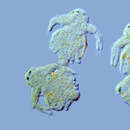en
names in breadcrumbs


Moina is a genus of crustaceans within the family Moinidae.[3][4] The genus was first described by W. Baird in 1850. They are referred to as water fleas, but are related to the much larger Daphnia magna and the larger Daphnia pulex.[5] This genus demonstrates the ability to survive in waters containing low oxygen levels, high salinity, and other impurities, including salt pans, and commonly eutrophication.[6] An example of such an extreme habitat is the highly saline Makgadikgadi Pans of Botswana, which supports prolific numbers of Moina belli.[7]
The Moina are known to be found in various types of bodies of water in Eurasia where new found research indicates that there is an increased presence of biodiversity in regions of Northern Eurasia, Japan and China.[8] According to genetic data, whole the genus Moina is divided into two big faunistic groups: European-Western Siberian and Eastern Siberian-Far Eastern, with a transitional zone at the Yenisey River basin (Eastern Siberia).[9] There is an increase of new phylogroups found in Northern Eurasia, an increase of 4 new Moina species in Japan and an increase of five new lineages in China.[9][10] In the water bodies of the world, at least 4 species of Moina are non-native species.[11]
Moina contains these species:[3][1]
Moina is a genus of crustaceans within the family Moinidae. The genus was first described by W. Baird in 1850. They are referred to as water fleas, but are related to the much larger Daphnia magna and the larger Daphnia pulex. This genus demonstrates the ability to survive in waters containing low oxygen levels, high salinity, and other impurities, including salt pans, and commonly eutrophication. An example of such an extreme habitat is the highly saline Makgadikgadi Pans of Botswana, which supports prolific numbers of Moina belli.
The Moina are known to be found in various types of bodies of water in Eurasia where new found research indicates that there is an increased presence of biodiversity in regions of Northern Eurasia, Japan and China. According to genetic data, whole the genus Moina is divided into two big faunistic groups: European-Western Siberian and Eastern Siberian-Far Eastern, with a transitional zone at the Yenisey River basin (Eastern Siberia). There is an increase of new phylogroups found in Northern Eurasia, an increase of 4 new Moina species in Japan and an increase of five new lineages in China. In the water bodies of the world, at least 4 species of Moina are non-native species.